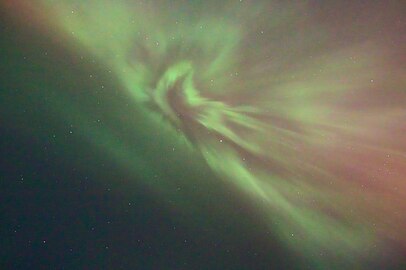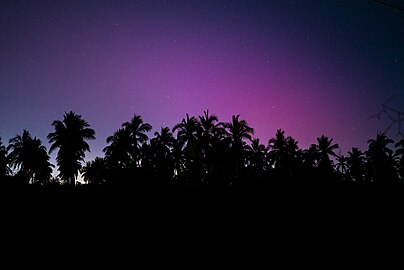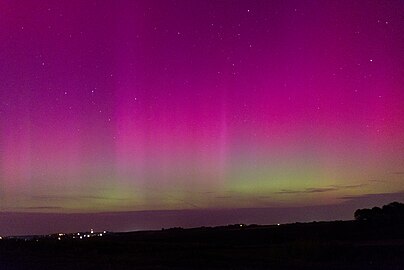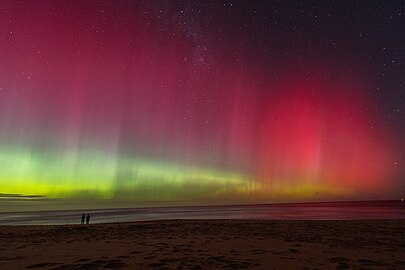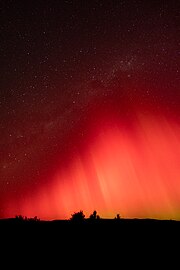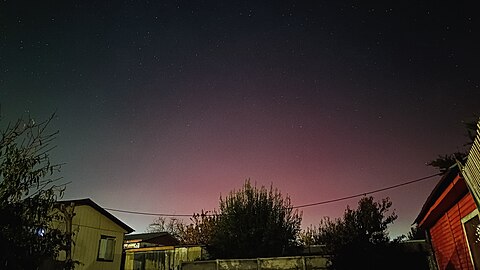May 2024 solar storms
 VIIRSimage showing the aurora borealis over the Northern Hemisphere on 10–11 May. | |
| Associated solar active region | |
|---|---|
| NOAA regionno. | 13664 |
| Largest SXR flares | X8.7 |
| G5 "Extreme" geomagnetic storm | |
| G-scale(NOAA/SWPC) | |
| Initial onset | 10 May 2024 |
| Peak onset | 11 May 2024 |
| Dissipated | 13 May 2024 |
| PeakKp-index | 9 |
| PeakAp-index | 271 |
| PeakDst | −412 nT |
Part ofsolar cycle 25 | |
Thesolar storms of May 2024were a series of powerfulsolar stormswith extremesolar flaresandgeomagnetic stormcomponents that occurred from 10–13 May 2024 duringsolar cycle 25.The geomagnetic storm was the most powerful to affect Earth sinceMarch 1989,[a]and producedauroraeat far more equatorial latitudes than usual in both theNorthernandSouthern Hemispheres.[1][2]
Solar flares and coronal mass ejections[edit]
On 8 May 2024, asolar active regionwhich had been assigned theNOAAregion number 13664 (AR3664) produced anX1.0-classand multiple M-classsolar flaresand launched severalcoronal mass ejections(CMEs) toward Earth.[3]On 9 May, the active region produced an X2.25- and X1.12-class flare each associated with a full-halo CME. On 10 May, the region produced an X3.98-class flare, and on 11 May at 01:23UTCit produced another X-class flare of magnitude 5.4–5.7 with another asymmetrical full-halo CME.[4][5][6]The region also caused an S1solar radiation stormwith spikes reaching S2.[7]On 14 May, as the most active region 3664 rotated beyond the sun's western limb, the strongest flare occurred, an X8.7, causing level R3 (strong) radio blackouts.[8]
Geomagnetic storm[edit]

As a result of theinterplanetary magnetic fieldreaching a magnitude of73nanotesla(nT), with the component along Earth's magnetic axis oriented south reaching as much as−50 nT,the moderately highsolar winddensity, and the solar wind speed reaching 750–950 km/s (470–590 mi/s) between 11 and 12 May (UTC time), the event was classified as a G5-class geomagnetic storm (Kp= 9), making it the most intense storm since the2003 Halloween solar storms.[9][10]Several other CMEs were expected to reach Earth on 11 and 12 May.[11]
Comparison to other geomagnetic storms[edit]
Thedisturbance storm time index(Dst index) is a measure in the context of space weather. A negative Dst index means thatEarth's magnetic fieldis weakened.[12]This is particularly the case during solar storms, with a higher negative Dst index indicating a stronger solar storm.
The2003 Halloween solar stormshad a peak Dst index of −383 nT, although a second storm on 20 November 2003 reached −422 nT while not reaching G5-class.[13][14]TheMarch 1989 geomagnetic stormhad a peak Dst index of −589 nT,[15]while theMay 1921 geomagnetic stormhas been estimated to have had a peak Dst index of−907±132 nT.Estimates for the peak Dst index of theCarrington Eventsuperstorm of 1859 are between−800 nTand−1750 nT.[16]
The May 2024 solar storms reached a peak Dst index of−412 nTat 03:00 UTC on 11 May.[17]
TheAp-indexof 11 May 2024 was 271, higher than theAp-indexes of 13 and 14 March 1989, significantly higher than theAp-indexes of 29 and 30 October and 20 November 2003, and the second-highest ever recorded, after theAp-index of 13 November 1960, which was 280.[18]
Aurora sightings[edit]
Three CMEs from 8 May reached Earth on 10 May 2024, causing severe to extreme geomagnetic storms with bright and very long-lasting aurorae.
InNorth America,aurorae were seen across theUnited Statesas far south as theFlorida Keys,[21][22][23]as well as from theYucatán PeninsulainMexico,[24]The Bahamas,[25]Jamaica,[26][27]andPuerto Rico.[28][29]The aurora was also seen inHawaii.[30]
Aurorae were seen acrossEuropefrom as far south asPortugal,[31]Spain,[32]andSardinia.[33]Aurorae were also visible inAlgeriaand theCanary IslandsinAfrica.[34][35]
InAsia,aurorae could be seen fromTurkey,[36]Cyprus,[37]Iran,[38]Japan,[39]northernIndia,[40]and across northernChina,[26]including near the cities ofUrumqiandBeijing.[41][42]
InAustralia,aurorae were seen as far north asTownsvilleandMackayinQueensland,[43][44]while in the rest of the Southern Hemisphere aurorae were seen inNew Zealand,[45]Chile,Argentina,[46]South Africa,[47]and as far north asNew Caledonia,[48]Uruguay,southernBrazil,[49]andNamibia.[47]
While aurorae were able to be seen on camera from many locations across the globe, at locations farther away from the poles where the aurora is less bright, the aurora can often appeardesaturated,achromatic,or even invisible to the naked eye as a result of thePurkinje effect.[50][51]
Camera technology has improved since the last G5-class geomagnetic storm in2003,with even standard cell phone cameras having enough sensitivity to pick up the colours of an aurora.[52]Consequently, images of aurorae were spread widely acrosssocial media,with much public excitement being generated during the event.[53]The ability to document aurorae at such a wide scale has provided a large opportunity to learn more about the phenomenon.[52]
Impact[edit]
The storm negatively affected ground-based broadcasting and two-way radio communications, especially on theHFband and to a lesser extent theVHFandUHFbands, because it increased the density of the D layer of theionosphere,causing absorption and thus interfering withpropagation.[54][55]
In Canada, power companiesBC HydroandHydro-Québecstated that they had prepared for the storm, and monitored it as its ejecta struck Earth on 10–11 May. Unlike in 1989 wherea previous solar stormcaused a nine-hour long power outage inQuébec,no outages were reported as a result of the storm's effects.[56][57]
In New Zealand,Transpowerdeclared a grid emergency, and took some transmission lines out of service as a precaution against the storm.[58]
In the United States, telecommunications companiesAT&TandT-Mobilestated that they were prepared to respond to disruptions in their networks, but it was predicted that significant impacts to cell service were unlikely because the networks rely on different frequencies than the HF bands affected by the solar storm.[59]While theNational Oceanic and Atmospheric Administration(NOAA) reported that there were power grid irregularities and degradation inGPSandhigh-frequencyradio communications,[60]both theFederal Emergency Management Agency(FEMA) and theUnited States Department of Energyreported no significant impacts to the population.[61]
Agricultural users ofJohn DeereRTKGPSequipment reported significantly degraded positional accuracy during the geomagnetic storm. As the GPS receivers are used to guide tractors inprecision agriculture,certain agricultural workers were forced to suspendplantingactivities entirely.[62][63]
University of Victoriaresearchers discovered that the geomagnetic storm triggered compasses in sub-sea observatories deployed as deep as 2.7 km under the ocean’s surface.[64]
Someaerial droneusers flying during the storm experienced unusual behavior, including difficulty maintaining a stable hover, disruption of GPS signals, and in some cases a sudden loss of control which resulted in a crash.[65][66]Drones rely on GPS and magnetic signals to maintain position during flight, which are affected by geomagnetic activity.
At 00:19 UTC on 13 May, theGOES-16satellite, the primary operational geostationaryweather satellitein the GOES East position, providing a view centered on the Americas, stopped transmitting all data. The transmission of data resumed nearly 2 hours later at 02:00 UTC.[67]There was a second loss of data transmission shortly after, lasting 11 minutes from 03:19 UTC to 03:30 UTC.[68]
Other impacts to satellite services includeStarlink's fleet of low-orbiting satellites, which experienced degraded service because of the intensity of the solar storms, but remained operational.[69][70][71]
Gallery[edit]
Auroras were visible in many regions around the world, and far from the magnetic poles. These figures demonstrate the spread of the aurorae on the night of 10 and 11 May. Captions indicategeographic latitude(GLAT) first, andmagnetic latitude(MLAT) second, using the quasi-dipole latitude ofIGRF-13model.
-
Aurora at zenith,Onawa, Iowa,U.S. (42°N GLAT, 51°N MLAT)
-
Viola, Arkansas,U.S. (36°N GLAT, 46°N MLAT)
-
Pawleys Island, South Carolina,U.S. (33°N GLAT, 43°N MLAT)
-
Mazatlán,Mexico (23°N GLAT, 31°N MLAT)
-
Aurora at zenith,Brastad,Sweden (58°N GLAT, 55°N MLAT)
-
Cwmbran, Wales,U.K. (51°N GLAT, 47°N MLAT)
-
Kraków,Poland (50°N GLAT, 46°N MLAT)
-
Oria,Italy (40°N GLAT, 34°N MLAT)
-
Altay,China (48°N GLAT, 44°N MLAT)
-
Perth,Australia (32°S GLAT, 43°S MLAT)
-
Melbourne,Australia (38°S GLAT, 48°S MLAT)
-
Auckland,New Zealand (37°S GLAT, 42°S MLAT)
-
Quillón,Chile (36°S GLAT, 24°S MLAT)
Notes[edit]
- ^It had the largest peak negative Dst index (−412 nT) of any G5-class storm since 1989.
See also[edit]
References[edit]
- ^Miller, Katrina; Penn, Ivan; Lindner, Emmett (11 May 2024)."Northern Lights Set to Return During Extreme Solar Storm's 2nd Night – Electrical utilities said they weathered earlier conditions as persistent geomagnetic storms were expected to cause another light show in evening skies".The New York Times.Archivedfrom the original on 12 May 2024.Retrieved12 May2024.
- ^Ralls, Eric (10 May 2024)."Auroras expected all weekend across the U.S. as massive solar storm hits Earth".Earth.Archivedfrom the original on 11 May 2024.Retrieved11 May2024.
- ^"Sunspot region 3664, major flares and CMEs!".SpaceWeatherLive. 8 May 2024.Archivedfrom the original on 9 May 2024.Retrieved11 May2024.
- ^"Sunspot region AR13664".SpaceWeatherLive.Archivedfrom the original on 11 May 2024.Retrieved11 May2024.
- ^"CME impact imminent, Two more earth-directed CMEs".SpaceWeatherLive. 10 May 2024.Archivedfrom the original on 10 May 2024.Retrieved11 May2024.
- ^"Yet Another X-class Flare!".Space Weather Prediction Center.National Oceanic and Atmospheric Administration.11 May 2024.Archivedfrom the original on 11 May 2024.Retrieved11 May2024.
- ^"Solar Photons archive, 10 May 2024".Space Weather Live.10 May 2024.Archivedfrom the original on 12 May 2024.Retrieved11 May2024.
- ^"Region 3664 not done yet! Produces X8.7 flare...largest of the solar cycle!".Space Weather Prediction Center.US National Oceanic and Atmospheric Administration.Archivedfrom the original on 15 May 2024.Retrieved15 May2024.
- ^"Strongest geomagnetic storm since 2003, X5.8 solar flare".SpaceWeatherLive. 11 May 2024.Archivedfrom the original on 11 May 2024.Retrieved11 May2024.
- ^"Viewing archive of Saturday, 11 May 2024 Solar wind (Speed, Density), Interplanetary Magnetic Field (IMF) (Bt, Bz)".SpaceWeatherLive.Archivedfrom the original on 13 May 2024.Retrieved13 May2024.
- ^"SWPC Issues Its First G4 Watch Since 2005".Space Weather Prediction Center.9 May 2024.Archivedfrom the original on 10 May 2024.Retrieved11 May2024.
- ^Abduallah, Yasser; Wang, Jason T. L.; Bose, Prianka; Zhang, Genwei; Gerges, Firas; Wang, Haimin (5 May 2022),A Deep Learning Approach to Dst Index Prediction,arXiv:2205.02447
- ^"Let's compare! Halloween 2003 VS May 2024 Solar Storms!".SpaceWeatherLive.17 May 2024.Archivedfrom the original on 17 May 2024.Retrieved18 May2024.
- ^"Top 50 geomagnetic storms of 2003".SpaceWeatherLive.Archivedfrom the original on 11 May 2024.Retrieved18 May2024.
- ^Boteler, D. H. (10 October 2019)."A 21st Century View of the March 1989 Magnetic Storm".Space Weather.17(10): 1427–1441.Bibcode:2019SpWea..17.1427B.doi:10.1029/2019SW002278.ISSN1542-7390.
- ^"Near Miss: The Solar Superstorm of July 2012".NASAScience.Archivedfrom the original on 11 May 2024.Retrieved11 May2024.
- ^"Real-time Dst Index".World Data Center for Geomagnetism, Kyoto.Archivedfrom the original on 10 May 2024.Retrieved11 May2024.
- ^"Top 50 geomagnetic storms".SpaceWeatherLive.Archivedfrom the original on 21 May 2024.Retrieved21 May2024.
- ^Clark, Stuart (2007). "Astronomical fire: Richard Carrington and the solar flare of 1859".Endeavour.31(3): 104–109.doi:10.1016/j.endeavour.2007.07.004.PMID17764743.
- ^"The colours of the northern lights"Archived18 May 2024 at theWayback Machineat Canadian Space Agency. Retrieved May 18, 2024
- ^Miller, Katrina; Jones, Judson (10 May 2024)."Solar Storm Intensifies, Filling Skies With Northern Lights".The New York Times.Archivedfrom the original on 11 May 2024.Retrieved11 May2024.
- ^Fritz, Angela; Hammond, Elise; Lau, Chris (10 May 2024)."Live updates: The latest on the massive solar storm".CNN.Archivedfrom the original on 11 May 2024.Retrieved11 May2024.
- ^"'Unbelievable!': Northern Lights seen in South Florida from 'severe' solar storm ".NBC 6 South Florida.Associated Press.11 May 2024.Archivedfrom the original on 11 May 2024.Retrieved11 May2024.
- ^"Auroras boreales por primera vez en Yucatán"[Aurora borealis for the first time in Yucatán].Tribuna Campeche[Campeche Tribune] (in Spanish). 11 May 2024.Archivedfrom the original on 12 May 2024.Retrieved12 May2024.
- ^"Northern Lights Likely To Illuminate Night Sky Again Amid" Extreme "Solar Storm".NDTV.Archivedfrom the original on 12 May 2024.Retrieved13 May2024.
- ^abNghiêm mậu cường."Stunning red sky over China wins fans online".chinadaily.cn.Archivedfrom the original on 15 May 2024.Retrieved19 May2024.
- ^"Josh on X:" Taken with my iPhone unfiltered from Ocho Rios Jamaica... "".X.11 May 2024.Retrieved20 June2024.
- ^Garofalo, Meredith (13 May 2024)."How a giant sunspot unleashed solar storms that spawned global auroras that just dazzled us all".Space.Archivedfrom the original on 15 May 2024.Retrieved15 May2024.
- ^"Paco Bellido on X:" ¡La aurora se ha visto hasta en Puerto Rico!... "".X.11 May 2024.Retrieved20 June2024.
- ^Schenfeld, Nikki (12 May 2024)."Northern lights seen in Hawaii! First time in over a century".KHON2.Archivedfrom the original on 12 May 2024.Retrieved13 May2024.
- ^Hughes, Tobi (11 May 2024)."Northern lights visible in the skies of Portugal".Madeira Island News Blog.Archivedfrom the original on 14 May 2024.Retrieved13 May2024.
- ^Ortiz, Marina (11 May 2024)."La tormenta geomagnética más fuerte de los últimos 20 años provoca una gran aurora boreal visible en toda España"[The strongest geomagnetic storm of the past 20 years causes a great aurora borealis visible in all of Spain].ABC Ciencia(in Spanish). Diario ABC, S.L.Archivedfrom the original on 12 May 2024.Retrieved12 May2024.
- ^Onano, Giorgio Ignazio (11 May 2024)."The Northern Lights color the Sardinian night: the show from the north to the south of the island".L'Unione Sarda English.Archivedfrom the original on 19 May 2024.Retrieved19 May2024.
- ^"Due to the solar storm, and in a historical precedent, the northern lights were seen from Algeria and areas on the equator".arabiaweather.Archivedfrom the original on 20 May 2024.Retrieved15 May2024.
- ^"Canary Islands witness the spectacle of the Northern Lights".Canarian Weekly.11 May 2024.Archivedfrom the original on 14 May 2024.Retrieved13 May2024.
- ^"Auroras over Turkey's northern coasts".bianet.org.Archivedfrom the original on 17 May 2024.Retrieved19 May2024.
- ^"Northern Lights captured for first time over Cyprus in rare event, Kitasweather says [VIDEO]".in-cyprus.philenews.13 May 2024.Archivedfrom the original on 11 May 2024.Retrieved13 May2024.
- ^"Explaining the Historical Geomagnetic Storm of 10th May 2024 – The Day Earth Lit Up with Red Auroras".Whistling Hound.13 May 2024.Archivedfrom the original on 19 May 2024.Retrieved19 May2024.
- ^NEWS, KYODO."Auroras illuminate night skies across world, parts of Japan".Kyodo News+.Archivedfrom the original on 12 May 2024.Retrieved13 May2024.
- ^Sengupta, Trisha (11 May 2024)."Aurora illuminates sky in Ladakh's Hanle as extreme solar storm hits Earth: 'Extraordinarily beautiful'".Hindustan Times.Archivedfrom the original on 11 May 2024.Retrieved12 May2024.
- ^huaxia, ed. (11 May 2024)."View of northern lights in Urumqi".XinhuaNet.Xinhua.Archivedfrom the original on 11 May 2024.Retrieved12 May2024.
- ^Dang, Yuanyue (12 May 2024)."China basks in northern light show – and more may be on the way".South China Morning Post.Archivedfrom the original on 13 May 2024.Retrieved13 May2024.
- ^"Southern lights shock stargazers in Townsville".Townsville Bulletin.Archivedfrom the original on 20 May 2024.Retrieved18 May2024.
- ^"Media Releases - Bureau of Meteorology Newsroom".media.bom.gov.au.Archivedfrom the original on 12 May 2024.Retrieved13 May2024.
- ^"Incredible photos: Stunning aurora dazzles NZ skies".NZ Herald.11 May 2024.Archivedfrom the original on 11 May 2024.Retrieved11 May2024.
- ^"Aurora Austral impresiona en los cielos del sur de Chile"[Aurora Australis impresses in the skies of southern Chile] (in Spanish). MSN. 11 May 2024.Archivedfrom the original on 12 May 2024.Retrieved11 May2024.
- ^abIderawumi, Mustapha (11 May 2024)."Southern African Skies Light Up with Aurora as Historic Solar Storm Collides with Earth".Space in Africa.SANSA.Archivedfrom the original on 12 May 2024.Retrieved11 May2024.
- ^Mack, Eric."Epic Northern Lights Aurora This Month Tied To A Solar 'Great Storm'".Forbes.Archivedfrom the original on 19 May 2024.Retrieved19 May2024.
- ^"Cielo rojo: el extraño fenómeno de la aurora austral que se pudo ver en Uruguay"[Red sky: the strange phenomenon of the aurora australis that could be seen in Uruguay].Telenoche(in Spanish). 11 May 2024.Archivedfrom the original on 11 May 2024.Retrieved12 May2024.
- ^"Why your camera sees the night sky better than your eyes".Akari Photo Tours.Archivedfrom the original on 18 May 2024.Retrieved19 May2024.
- ^Mack, Eric."To See The Northern Lights Aurora This Weekend, Use Your Phone Camera".Forbes.Archivedfrom the original on 16 May 2024.Retrieved19 May2024.
- ^abJohnson-Groh, Mara; NASA."How NASA tracked the most intense solar storm in decades".phys.org.Archivedfrom the original on 17 May 2024.Retrieved17 May2024.
- ^AHMED, Issam."First 'extreme' solar storm in 20 years brings spectacular auroras".phys.org.Archivedfrom the original on 17 May 2024.Retrieved17 May2024.
- ^Ralls, Eric (11 May 2024)."'Extreme' and very rare G5-level solar storm hits Earth on Saturday ".Earth.Archivedfrom the original on 11 May 2024.Retrieved11 May2024.
- ^Persons, Mark (13 May 2024)."What I Heard During the Solar Event".Radio World.Archivedfrom the original on 14 May 2024.Retrieved14 May2024.
- ^"Major solar storm hits Canada, bringing risks and aurora, B.C. Hydro monitoring".Vancouver Sun.The Canadian Press.10 May 2024.Archivedfrom the original on 11 May 2024.Retrieved12 May2024.
- ^"Solar storm spares province of any power outages, Hydro-Québec says".The Gazette.Montreal Gazette.La Presse Canadienne.10 May 2024.Archivedfrom the original on 12 May 2024.Retrieved12 May2024.
- ^"Solar storm: Transpower extends grid emergency declaration".1 News.Archivedfrom the original on 12 May 2024.Retrieved11 May2024.
- ^Sutton, Joe; Smart, Sara (10 May 2024)."AT&T and TMobile say they ready to respond to any impacts from geomagnetic storm".CNN.Archivedfrom the original on 11 May 2024.Retrieved12 May2024.
- ^"G5 Conditions Reached Yet Again!".Space Weather Prediction Center.Boulder, CO:National Oceanic and Atmospheric Administration.11 May 2024.Archivedfrom the original on 11 May 2024.Retrieved12 May2024.
- ^Krisher, Tom; Funk, Josh; Dunn, Marcia (11 May 2024)."Solar storm puts on brilliant light show across the globe, but no serious problems reported".apnews.The Associated Press.Archivedfrom the original on 12 May 2024.Retrieved11 May2024.
- ^Koebler, Jason (12 May 2024)."Solar Storm Knocks Out Farmers' Tractor GPS Systems During Peak Planting Season".404 Media.Archivedfrom the original on 12 May 2024.Retrieved12 May2024.
- ^Davis, Wes (12 May 2024)."Solar Storms are disrupting farmer GPS systems during critical planting time".The Verge.Archivedfrom the original on 12 May 2024.Retrieved13 May2024.
- ^"Northern Lights affected University of Victoria's deep sea observatories".16 May 2024.Archivedfrom the original on 16 May 2024.Retrieved16 May2024.
- ^"Geomagnetic Storm Watch".DJI Mavic, Air & Mini Drone Community.10 May 2024.Archivedfrom the original on 14 May 2024.Retrieved13 May2024.
- ^bluereptile (12 May 2024)."$3k down the drain".r/dji.Archivedfrom the original on 13 May 2024.Retrieved13 May2024.
- ^"Correction: Length of the Outage/Event".ospo.noaa.gov.Archivedfrom the original on 13 May 2024.Retrieved13 May2024.
- ^"Topic: GOES-16 All Products and derived products delivered to AWIPS, GRB, PDA".ospo.noaa.gov.Archivedfrom the original on 13 May 2024.Retrieved13 May2024.
- ^Shetti, Utkarsh (11 May 2024). Williams, Alison; Mark, Potter (eds.)."Musk's Starlink satellites disrupted by major solar storm".Reuters.Archivedfrom the original on 13 May 2024.Retrieved11 May2024.
- ^Musk, Elon [@elonmusk](11 May 2024)."Major geomagnetic solar storm happening right now. Biggest in a long time. Starlink satellites are under a lot of pressure, but holding up so far"(Tweet).Retrieved11 May2024– viaTwitter.
- ^@SpaceX(12 May 2024)."All @Starlink satellites on-orbit weathered the geomagnetic storm and remain healthy"(Tweet).Retrieved25 May2024– viaTwitter.











